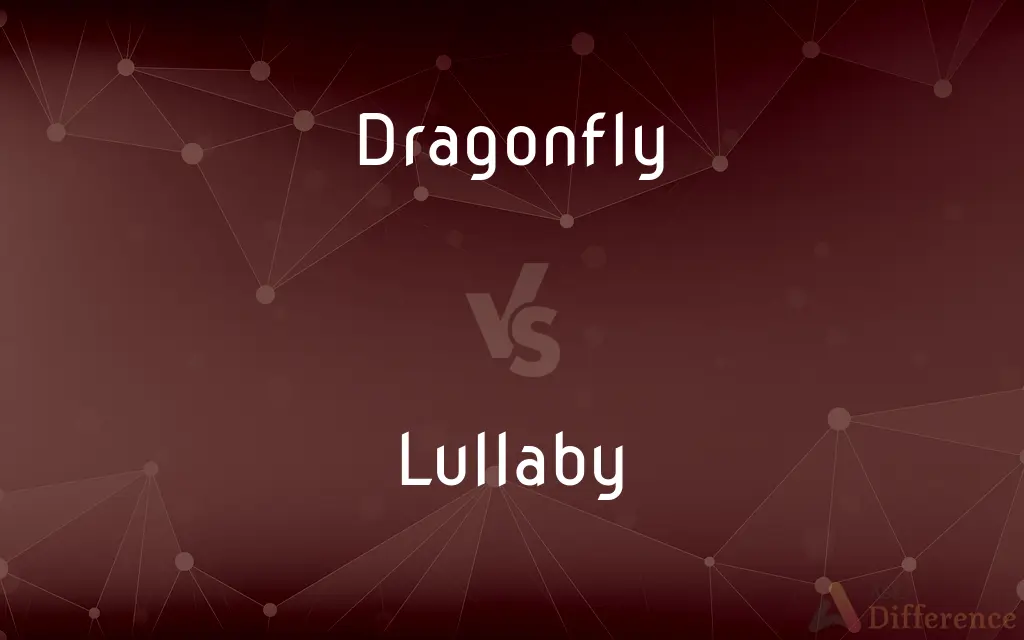Dragonfly vs. Lullaby — What's the Difference?
By Maham Liaqat & Fiza Rafique — Updated on March 24, 2024
A dragonfly is an insect known for its aerial agility and predatory habits, while a lullaby is a soothing song intended to lull a child to sleep.

Difference Between Dragonfly and Lullaby
Table of Contents
ADVERTISEMENT
Key Differences
Dragonflies are recognized for their elongated bodies, two pairs of strong, transparent wings, and large, multifaceted eyes, enabling them to hunt prey with precision while in flight. Lullabies, on the other hand, are melodic and gentle songs or pieces of music, often featuring repetitive, soothing motifs designed to calm or induce sleep, especially in infants.
While dragonflies are a part of the natural ecosystem, playing a crucial role in controlling mosquito populations and serving as indicators of environmental health, lullabies exist in the cultural realm, varying widely across different societies and often passed down through generations as a part of human heritage and parental care.
Dragonflies undergo a unique lifecycle that includes a significant portion of their life spent in the water during the nymph stage, which contrasts sharply with the ethereal, intangible nature of lullabies, which are auditory experiences that leave lasting emotional impressions rather than physical traces.
The beauty and grace of dragonflies in flight have inspired various forms of artistic expression, from poetry to visual arts, paralleling the way lullabies have been incorporated into music and literature, highlighting the human fascination with both natural phenomena and the power of musical soothing.
Despite their vastly different existences one being a biological entity and the other a cultural artifact—both dragonflies and lullabies evoke a sense of peace and wonder, be it through the serene flight of a dragonfly over a pond or the calming melody of a lullaby sung at a child's bedside.
ADVERTISEMENT
Comparison Chart
Nature
Biological entity, an insect
Cultural artifact, a song or piece of music
Purpose
Predation and population control of insects
Soothing and inducing sleep, especially in children
Existence
Physical, part of the natural world
Intangible, exists in auditory and cultural forms
Lifecycle
Includes aquatic nymph stage and aerial adult stage
Created, performed, and passed down through generations
Role in Human Culture
Often symbolizes change and adaptability
Used as a tool for nurturing and emotional connection
Compare with Definitions
Dragonfly
A predatory insect with transparent wings and an elongated body.
The dragonfly darted above the water, catching mosquitoes.
Lullaby
Can be used therapeutically for relaxation.
Therapists sometimes use lullabies to help patients with anxiety relax.
Dragonfly
Spends early life as an aquatic nymph before metamorphosing.
Dragonfly nymphs are voracious predators in pond ecosystems.
Lullaby
A gentle, soothing song sung to lull children to sleep.
She sang a lullaby to calm her newborn at bedtime.
Dragonfly
Known for impressive flight agility and speed.
Dragonflies can hover and change direction mid-air effortlessly.
Lullaby
Varies culturally but shares universal soothing qualities.
Lullabies around the world share the common goal of comforting children.
Dragonfly
Plays a vital role in controlling pest populations.
Gardeners appreciate dragonflies for their natural pest control abilities.
Lullaby
Characterized by simple, repetitive melodies.
The lullaby's melody was soft and repetitive, perfect for soothing.
Dragonfly
Symbolizes change in many cultures.
The dragonfly is often seen as a symbol of transformation and adaptability.
Lullaby
Often passed down through generations.
The lullaby has been in her family for generations, sung to all the children.
Dragonfly
Any of numerous predatory insects of the order Odonata, having large eyes, a long slender body, and two pairs of transparent veined wings, especially those of the order Anisoptera, which hold the wings outstretched when at rest, as distinguished from the damselflies. Also called regionally darner, darning needle, devil's darning needle, mosquito fly, mosquito hawk, needle, skeeter hawk, snake doctor, snake feeder, spindle.
Lullaby
A soothing song with which to lull a child to sleep.
Dragonfly
An insect of the suborder Epiprocta or, more strictly, the infraorder Anisoptera, having four long transparent wings held perpendicular to a long body when perched.
Lullaby
To quiet with or as if with a lullaby.
Lullaby
A cradlesong, a soothing song to calm children or lull them to sleep.
Sing a lullaby
Lullaby
(transitive) To sing a lullaby to.
Lullaby
A song to quiet babes or lull them to sleep; that which quiets.
Lullaby
Hence: Good night; good-by.
Lullaby
A quiet song intended to lull a child to sleep
Lullaby
A quiet song that lulls a child to sleep
Common Curiosities
What is a lullaby?
A lullaby is a soothing song or piece of music sung or played to help children fall asleep, characterized by its gentle, melodic nature.
What is a dragonfly?
A dragonfly is an insect known for its elongated body, two pairs of strong wings, and excellent flying abilities, often found near water bodies.
Why are lullabies important in child care?
Lullabies soothe infants and young children, helping them fall asleep with their calming melodies and rhythms, and fostering emotional bonds.
How do dragonflies contribute to the ecosystem?
Dragonflies control pest populations, such as mosquitoes, and serve as indicators of environmental health due to their sensitivity to water quality.
Are all lullabies meant for sleep?
While primarily intended to help children sleep, lullabies can also be used for calming and comfort at other times.
Can lullabies vary across different cultures?
Yes, lullabies vary widely across cultures, reflecting different musical traditions and themes, but they share the universal purpose of soothing and comforting.
What distinguishes a dragonfly from other insects?
Dragonflies are distinguished by their large, multifaceted eyes, two pairs of strong, transparent wings, and their ability to fly backward and hover.
How do dragonflies capture their prey?
Dragonflies catch their prey mid-air with incredible speed and precision, using their agile flight and sharp vision.
What stages are involved in a dragonfly's lifecycle?
A dragonfly's lifecycle includes an egg stage, an aquatic nymph stage where it is a predator in water, and an adult stage with aerial predation.
Do dragonflies have any cultural significance?
Yes, dragonflies symbolize change, adaptability, and the deeper aspects of life in many cultures, and are often featured in literature and art.
Can lullabies be created by anyone?
Yes, while there are traditional lullabies, new ones are continually being created by parents, musicians, and composers to soothe and comfort children.
How are lullabies shared or passed on?
Lullabies are often passed down through oral tradition, sung from parent to child, and can also be recorded and shared through various media.
Share Your Discovery

Previous Comparison
Delimitation vs. Limit
Next Comparison
Interactivity vs. InteractionAuthor Spotlight
Written by
Maham LiaqatCo-written by
Fiza RafiqueFiza Rafique is a skilled content writer at AskDifference.com, where she meticulously refines and enhances written pieces. Drawing from her vast editorial expertise, Fiza ensures clarity, accuracy, and precision in every article. Passionate about language, she continually seeks to elevate the quality of content for readers worldwide.














































